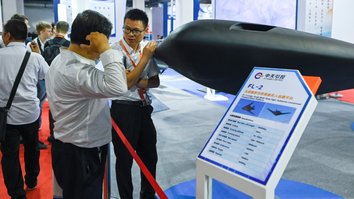TASHKENT -- The use of Iranian-made suicide drones by Russian forces in Ukraine has drawn attention to Tehran's attempts to gain influence in Central Asia, an effort of which countries in the region should be wary, say analysts.
Russian forces in October began strikes against Ukrainian civilian and critical infrastructure by using missiles and the Shahed-136, an Iranian-made drone that Russian forces rebranded as the Geran-2 (Geranium-2).
Since then, Russian forces have launched more than 400 Shahed-136s, Yurii Ihnat, a Ukrainian Air Force spokesman, said Wednesday (November 9).
Most of the drones were shot down, he said, according to Ukrinform.net.
However, the drones still spark terror in Ukrainians.
"I'm literally losing sleep at night because I'm so scared for my family, especially my kids. When we hear that awful buzzing sound a drone makes, we hide wherever we can," said Oleksandr Kovalenko, 43, a resident of Korsun-Shevchenkivskyi district, 120km from Kyiv, Ukraine.
"I've heard that the drones are Iranian, but we call them 'flying mopeds' because of the loud moped-like noise," Kovalenko told Caravanserai.
Pavlo Boiko, a 58-year-old resident of Kyiv, spotted one of the drones flying over his house at a height of about 200 metres.
"It sounds like a buzz saw or a moped. But it does a lot of nasty stuff. People have died and are still dying," Boiko told Caravanserai.
"The siren goes off at night, almost every hour and a half. My kids, grandchildren and wife are living in the basement," he said.
"By now soldiers have learned to shoot down these drones, but it doesn't matter -- [drones] are still flying shells. Even when you shoot them down, they detonate after they fall."
Iranian Foreign Minister Hossein Amir-Abdollahian on November 5 claimed that Iran "gave a limited number of drones to Russia months before the Ukraine war" but that it has not continued to supply weapons.
Tehran is lying, Ukrainian President Volodymyr Zelenskyy said in a statement the same day, adding that Ukrainian forces were downing at least 10 of the unmanned aerial vehicles (UAVs) every day.
The United States, alongside Britain and the European Union, already has imposed sanctions on Iran over its shipment of drones to Russia.
Last month, Kyiv decided to significantly reduce its diplomatic relations with Tehran over Iranian arms deliveries to Moscow.
Spotlight on Iranian weapons
The use of Iranian-made drones in Ukraine has brought into focus Tehran's influence in Central Asia after claims that the Shahed-136 were being produced in the region.
The Tajik Foreign Ministry released a statement on October 30 to deny that Tajik-made drones were being used for "killing Ukrainians", Eurasianet reported one day later.
"Tajikistan does not export military equipment to third countries," the ministry said in a statement posted on Facebook.
The denial came after Kyiv-based news outlet Hromadske on October 18 quoted Russian Middle East affairs pundit Sergei Danilov as saying that some of the drones might have been produced in Tajikistan or Syria.
"That undocumented allegation appears to have hinged on the detail that the chief of staff of Iran's armed forces, Maj.-Gen. Mohammad Bagheri, traveled to Dushanbe in May to attend the opening of a facility for the production of Iranian-designed Ababil-2 tactical drones," according to Eurasianet.
The Ababil-2, a different model from the Shahed-136, has been described by the US military as a single-engine multi-role tactical UAV that is most commonly used to train air-defence crews.
Tajikistan became a manufacturer of Iranian drones after its neighbour Kyrgyzstan began using Turkish-made Bayraktar drones against it, Shokir Khakimov of Dushanbe, a Tajik political scientist, told Caravanserai.
Tajikistan and Kyrgyzstan have had periodic border conflicts since the Soviet Union broke up in 1991.
"High-ranking authorised officials from both states [Iran and Tajikistan] ... announced in early 2022 that this decision was essential," he said.
Iranian engagement grows
The Tajik-made drones are just one example of Iran's efforts to gain influence in the region.
Despite the sanctions imposed on it, Iran is becoming a major arms producer in the region and is trying to insinuate itself into Central Asia, said Maxim Matnazarov, a historian from Nukus, Uzbekistan.
"Some Iranian politicians and historians have become convinced that the Central Asian countries and the peoples who live in them should come under Iran's influence because these lands were once part of the empire ruled by the Persians," Matnazarov told Caravanserai.
The post-Soviet resurgence of Islam in Central Asia has also become an impetus for Iran's aspirations in the region and potentially for the "export of the Islamic Revolution", he said.
"Tehran doesn't like to see the Central Asian countries pursuing a multivector foreign policy. It's trying to impose an anti-American direction ... on the region," he added.
"It's exporting military technology and building drone factories with the knowledge that peace in our region is very fragile."
Iran understands full well the potential for its drones to be used in Central Asian border disputes, he said.
World powers such as China and Russia have always taken an interest in Central Asia, said Adil Turdukulov of Bishkek, a journalist and analyst.
Nearby regional powers with cultural ties to Central Asia are trying to wield influence too, he said.
"Turkey is forging ties with Uzbekistan, Kazakhstan, Kyrgyzstan and Turkmenistan, and to counterbalance that, Iran is also trying to leverage certain cultural and ethnic elements and build its military presence in the region," Turdukulov told Caravanserai.
By operating a drone factory in Tajikistan, Iran is not trying to "support a fraternal people" but rather to strengthen its military influence in the region and show the West that it is an important geopolitical player, he said.

![Production of Iranian drones threatens security in Central Asia, observers say. Iranian drones bring death to Ukraine and represent danger for Central Asia, according to the graphic. [Caravanserai]](/cnmi_ca/images/2022/11/14/38617-iranian_drones-585_329.jpg)






A Kyrgyz analyst )) Sounds like Krusty the Clown :)
Reply3 Comment(s)
Not strange but foolish!!!
Reply3 Comment(s)